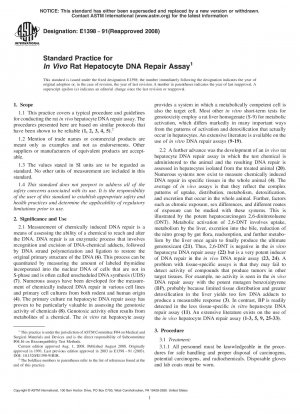ASTM E1398-91(2008)
Standard Practice for In Vivo Rat Hepatocyte DNA Repair Assay
- Standard No.
- ASTM E1398-91(2008)
- Release Date
- 1991
- Published By
- American Society for Testing and Materials (ASTM)
- Status
- 2014-01
- Latest
- ASTM E1398-91(2008)
- Scope
Measurement of chemically induced DNA repair is a means of assessing the ability of a chemical to reach and alter the DNA. DNA repair is an enzymatic process that involves recognition and excision of DNA-chemical adducts, followed by DNA strand polymerization and ligation to restore the original primary structure of the DNA (6). This process can be quantitated by measuring the amount of labeled thymidine incorporated into the nuclear DNA of cells that are not in S-phase and is often called unscheduled DNA synthesis (UDS) (7). Numerous assays have been developed for the measurement of chemically induced DNA repair in various cell lines and primary cell cultures from both rodent and human origin (4). The primary culture rat hepatocyte DNA repair assay has proven to be particularly valuable in assessing the genotoxic activity of chemicals (8). Genotoxic activity often results from metabolites of a chemical. The in vitro rat hepatocyte assay provides a system in which a metabolically competent cell is also the target cell. Most other in vitro short-term tests for genotoxicity employ a rat liver homogenate (S-9) for metabolic activation, which differs markedly in many important ways from the patterns of activation and detoxification that actually occur in hepatocytes. An extensive literature is available on the use of in vitro DNA repair assays (9-19).
A further advance was the development of an in vivo rat hepatocyte DNA repair assay in which the test chemical is administered to the animal and the resulting DNA repair is assessed in hepatocytes isolated from the treated animal (20). Numerous systems now exist to measure chemically induced DNA repair in specific tissues in the whole animal (4). The average of in vivo assays is that they reflect the complex patterns of uptake, distribution, metabolism, detoxification, and excretion that occur in the whole animal. Further, factors such as chronic exposure, sex differences, and different routes of exposure can be studied with these systems. This is illustrated by the potent hepatocarcinogen 2,6-dinitrotoluene (DNT). Metabolic activation of 2,6-DNT involves uptake, metabolism by the liver, excretion into the bile, reduction of the nitro group by gut flora, readsorption, and further metabolism by the liver once again to finally produce the ultimate genotoxicant (21). Thus, 2,6-DNT is negative in the in vitro hepatocyte DNA repair assay (22) but is a very potent inducer of DNA repair in the in vivo DNA repair assay (23, 24). A problem with tissue-specific assays is that they may fail to detect activity of compounds that produce tumors in other target tissues. For example, no activity is seen in the in vivo DNA repair assay with the potent mutagen benzo(a)pyrene (BP), probably because limited tissue distribution and greater detoxification in the liver yields too few DNA adducts to produce a measurable response (3). In contrast, BP is readily detected in the less tissue-specific in vitro hepatocyte DNA repair assay (11). An extensive literature exists on the use of the in vivo hepatocyte DNA repair assay (1-3, 5, 9, 25-33).
1.1 This practice covers a typical procedure and guidelines for conducting the rat in vivo hepatocyte DNA repair assay. The procedures presented here are based on similar protocols that have ......
ASTM E1398-91(2008) history
- 1991 ASTM E1398-91(2008) Standard Practice for In Vivo Rat Hepatocyte DNA Repair Assay
- 1991 ASTM E1398-91(2003) Standard Practice for the in vivo Rat Hepatocyte DNA Repair Assay
- 1991 ASTM E1398-91(1998) Standard Practice for the in vivo Rat Hepatocyte DNA Repair Assay
